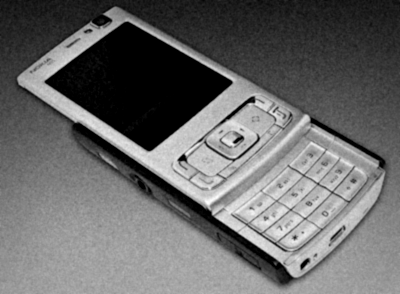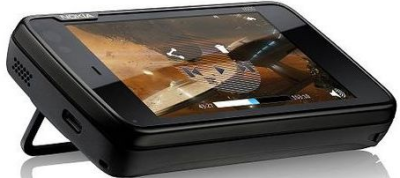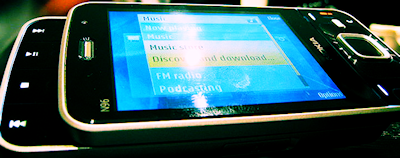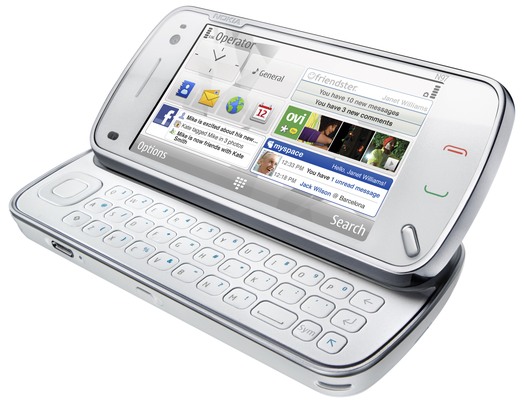Memory Lane, Part 2
Following on from part 1, as a new addition to Jay’s team here, here’s a look at what the second half of the last decade looked like for me, in terms of Nokia devices and the evolution of their specifications.
 My upgrade opportunity in 2007 was well-timed for the arrival of the iconic N95. Until this point, Nokia had a habit of picking and choosing features for different handsets, but for the first time they brought together most of their best hardware and functionality into one place. Here’s a look at it in comparison with the N70…
My upgrade opportunity in 2007 was well-timed for the arrival of the iconic N95. Until this point, Nokia had a habit of picking and choosing features for different handsets, but for the first time they brought together most of their best hardware and functionality into one place. Here’s a look at it in comparison with the N70…
| Released | 2007 | (+2 years) |
| Processor | Dual 332MHz | (+112MHz, or x1.51) |
| OS | Symbian 9.2 (Series 60 3rd Edition) | |
| Dimensions (mm) | 99 x 53 x 21 (110,187 volume), 120g | (-16,907 volume, -6g) |
| Storage | 160Mb + MicroSD (commonly 128Mb) | (+128Mb, +64Mb for MicroSD) |
| Camera | 5MP | (+3 MP) |
| Battery | 950mAh | (-20mAh) |
| Screen | 240 x 320, 16M colours, 2.6″ | (more pixels, more colours, +0.5″) |
| Connectivity | 2G, EDGE, 3G, Wifi |
Noteworthy for its sliding form factor, the N95 was pretty robust. Mine went through a fair share of bumps and scratches and was working all the way up to the end, even with the battery cover being held on by sticky tape. I would also say it was more deserving of the NSeries label than the N70, with storage well into the realm of gigabytes if you wanted it, an improved screen, impressive media playback features and the massive leap camera quality with the move to 5MP, and branded Carl Zeiss optics.
The next step on my Nokia-filled road of phone use was a bit of a bumpy one. I skipped the N95 8Gb, with its massive (for the time) internal storage, and keenly grabbed hold of a N96 when Nokia released it…
| Released | 2008 | (+1 year) |
| Processor | Dual 264MHz | (-68MHz, or x-0.80) |
| OS | Symbian 9.3 (Series 60 3rd Edition FP2) | |
| Dimensions (mm) | 103 x 55 x 18 (101,970 volume), g | (-8,217 volume, -g) |
| Storage | 16Gb + MicroSD | (+lots) |
| Camera | 5MP | |
| Battery | 950mAh | |
| Screen | 240 x 320, 16M colours, 2.8″ | (+0.2″) |
| Connectivity | 2G, EDGE, 3G, Wifi |
Definitely an evolution of the N95, on the face of things it doesn’t have particularly bad specifications. However, it was let down by buggy firmware and a lack of support from Nokia. All round the device just seemed like a rushed attempt to repeat the N95, without actually making any leaps in technology. With devices like the iPhone showing off what they could do, the N96 generally let everyone down. It actually had a slower processor than its predecessor. Very simply, it didn’t really do anything new.
As an aside before I move on, I should point out that I am aware that there is more to performance in devices than just processor speed. Behind the scenes, the Symbian OS was continuing to evolve, even through firmwares, into being more secure, more robust, and more efficient so that it could achieve more with the same CPU cycles and comparable battery life.
The Nokia 5800 was the device that brought Nokia back into the game as the touchscreen revolution pushed onwards, but I had a taste of the cutting edge from my time with my N95, and so I didn’t change handset until the N97 came along, combining the form factor of a full touch screen with a sliding qwerty keyboard – something I had been longing for since leaving my 9210 and Psion devices behind…
| Released | 2009 | (+1 year) |
| Processor | 434MHz | (+170MHz, or x1.64) |
| OS | Symbian 9.4 (Series 60 5th Edition) aka Symbian^1 | |
| Dimensions (mm) | 117 x 55 x 16 (102,960 volume), 150g | (+990 volume, +30g) |
| Storage | 32Mb + MicroSD | (+16Gb) |
| Camera | 5MP | |
| Battery | 1500mAh | (+550mAh) |
| Screen | 360 x 640, 16M colours, 3.5″ | (more pixels, +0.7″) |
| Connectivity | 2G, EDGE, 3G, Wifi |
Culture was shifting a bit now, as devices with large, bright screens became more accepted. The split between smartphones and dumbphones was more clear, with clear differences between those that wanted everything from their phone (applications, email, calendar, web, media…), to those that just wanted to phone and text (with music junkies sitting in the middle).
The N97 brought back functionality that I had missed since my days with the 9210. I found it interesting that despite the ability to use a full qwerty keyboard and a wide landscape oriented screen, I quite often fell back on one-handed portrait operation for common tasks such as web browsing and text messaging. Perhaps the combination of being small enough to fit in one hand along with the haptic feedback and my reliance on T9 in the past encouraged this.
Still, the N97 did feel a little rough around the edges. As much as I loved Symbian – and still do today – the transition to a touch-based UI wasn’t a smooth one. While firmware updates helped, the experience using the interface and the application just didn’t come close to that of my iPod touch. However, I decided a long time ago that the iPhone wouldn’t be a viable alternative – I was too used to having a good quality camera and the ability to truly multitask on my phone, and I wasn’t about to give this up after almost a decade.
 And then Nokia announced the N900, an evolution of their Internet Tablet platform into the world of telephony. Unmentioned in this article so far is that I did buy a Nokia N800 Internet Tablet somewhere in the late 2000’s, and was pleasantly surprised by Nokia’s Maemo operating system. With the N900, we had a device with a decent hardware keyboard, an excellent screen, a very hackable and open operating system and enough processing power to do almost anything. Put simply, even though it’s a move away from Symbian, I had to have one…
And then Nokia announced the N900, an evolution of their Internet Tablet platform into the world of telephony. Unmentioned in this article so far is that I did buy a Nokia N800 Internet Tablet somewhere in the late 2000’s, and was pleasantly surprised by Nokia’s Maemo operating system. With the N900, we had a device with a decent hardware keyboard, an excellent screen, a very hackable and open operating system and enough processing power to do almost anything. Put simply, even though it’s a move away from Symbian, I had to have one…
| Released | 2010 | (+1 year) |
| Processor | 600MHz + 430MHz | |
| OS | Maemo 5 | |
| Dimensions (mm) | 111 x 60 x 18 (119,880 volume), 181g | (+16,920 volume, +31g) |
| Storage | 32Gb + MicroSD | |
| Camera | 5MP | |
| Battery | 1320mAh | (-180mAh) |
| Screen | 800 x 480, 16M colours, 3.5″ | (more pixels) |
| Connectivity | 2G, EDGE, 3G, Wifi |
Ignoring a couple of minor issues over battery life, I find myself very happy with the N900 – especially after its finally receiving the anticipated PR1.2 firmware update. One lesson I’ve learned over the years is that there’s no such thing as a perfect device though. Before owning a N900, it seemed too good to be true, but small details such as the lack of MMS support and the more limited Ovi Maps and Ovi Store, stood out. Fortunately, most of the issues are addressed by third-party tools or are (slowly) receiving some attention from Nokia.
Despite finally having a device with the power and features that I like, I nonetheless find myself looking forward and considering what I’m going to do next. There’s a small part of me that’s tempted to give Android devices a look, as it’s shown some huge improvement over the last year or so. More likely though, I’ll look to the Nokia N8 (or its Symbian successor) or the rumoured N9 running MeeGo – the fabled ‘5th device out of 5’ in the line of Internet Tablets from Nokia.
Until then I shall continue to enjoy my N900, and tinker with it to get the most out of it. When I discover items of interest through my own dabbling or exploration of resources online, I’ll endeavour to share them with the My Nokia Blog audience here…







Connect
Connect with us on the following social media platforms.